The Reverse Transcriptase Enzymes Market is estimated to be valued at USD 370.3 million in 2025 and is projected to reach USD 517.4 million by 2035, registering a compound annual growth rate (CAGR) of 3.4% over the forecast period.
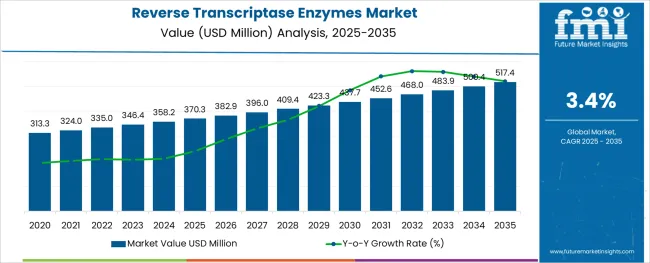
The reverse transcriptase enzymes market is experiencing steady growth, fueled by the expanding use of molecular biology techniques across biotechnology, academic, and clinical research institutions. The increasing adoption of RNA-based technologies, particularly in transcriptome analysis, infectious disease research, and personalized medicine, is reinforcing demand for high-fidelity enzymes that enable efficient reverse transcription.
Advancements in enzyme engineering have improved reaction specificity, thermal stability, and inhibitor resistance, enabling researchers to conduct highly accurate cDNA synthesis from RNA templates. The growth of RNA sequencing and point-of-care testing platforms is further propelling reagent consumption.
Strategic investments in life science R&D and infrastructure by public and private entities globally are accelerating the adoption of reverse transcriptase enzymes in both foundational research and translational applications. As RNA therapeutics and biomarker discovery continue to evolve, the market is expected to remain highly dynamic with future growth shaped by the demand for ultra-sensitive, rapid, and scalable reverse transcription technologies.
The market is segmented by Application and Product Type and region. By Application, the market is divided into Research Application and Medical Application. In terms of Product Type, the market is classified into Reagents Application, Primers Application, and Others. Regionally, the market is classified into North America, Latin America, Western Europe, Eastern Europe, Balkan & Baltic Countries, Russia & Belarus, Central Asia, East Asia, South Asia & Pacific, and the Middle East & Africa.
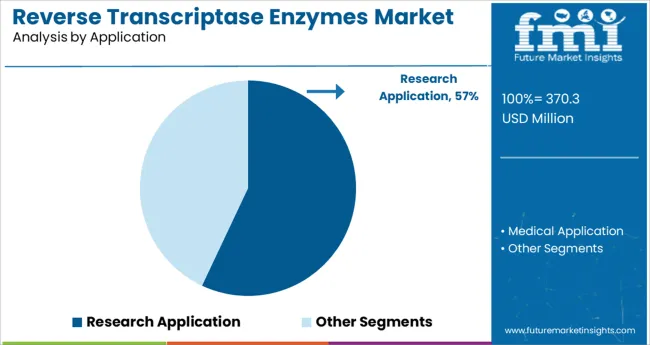
The research application segment is expected to contribute 57.0% of the total revenue in 2025, establishing it as the leading application area in the reverse transcriptase enzymes market. This dominance is being driven by the widespread use of reverse transcription in gene expression analysis, RNA sequencing, and the validation of molecular biomarkers.
Academic institutions, pharmaceutical companies, and biotech firms are increasingly relying on high-performance enzymes to support basic and applied RNA research. The need for reliable cDNA synthesis from low-input RNA samples and complex biological matrices has further reinforced demand within the research landscape.
Innovations in enzyme chemistry and the availability of ready-to-use kits tailored for advanced molecular workflows have also streamlined adoption. As government funding and private investment in life sciences research expand globally, the research application segment is positioned to maintain its leadership in driving enzyme utilization.
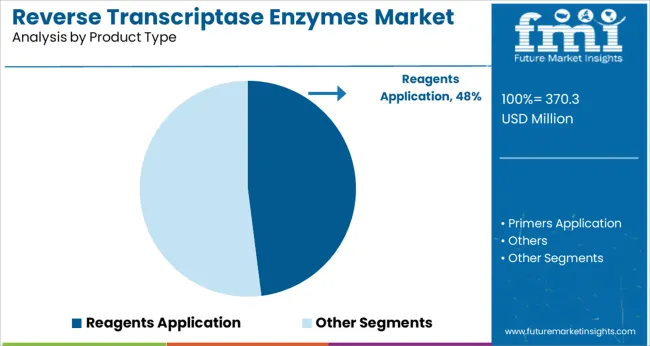
In terms of product type, the reagents segment is projected to account for 48.0% of the total revenue in 2025, making it the dominant category. This leadership is attributed to the consistent and high-volume consumption of reagents such as reverse transcriptase buffers, primers, dNTPs, and enzyme formulations in routine laboratory workflows.
The shift toward standardized and pre-formulated reagent systems has improved reproducibility, efficiency, and ease of use, especially in high-throughput research and diagnostic labs. Suppliers have been focusing on developing reagents that offer improved thermal stability, reduced reaction time, and compatibility with a wide range of templates, further expanding their applicability.
The integration of reagents into complete assay kits and automation-compatible formats has also strengthened their presence in core research settings. As molecular testing scales across geographies and disciplines, the reagents segment is expected to remain a critical contributor to overall market expansion.
Reverse transcriptase enzymes are biological molecules that help patients with cancer and retrovirology, which is anticipated to raise the demand for reverse transcriptase enzymes. To get rid of them, the adoption of reverse transcriptase enzymes is likely to grow all around the region during the forecast period.
Other diseases, such as HIV and Hepatitis B, are slowed down with the help of reverse transcriptase enzymes, which also leads to an increase in the sales of reverse transcriptase enzymes. It helps to replicate the genomes by mobile genetic elements are likely to boost the reverse transcriptase enzymes market growth as well as the reverse transcriptase enzymes market future trends during the forecast period.
It also allows RNA to work in the formation of a template to permit the enzyme to contaminate the cell (host cell), which is estimated to raise the reverse transcriptase enzymes market size in the recent year. Based on application, reverse transcriptase enzymes are categorized into research applications and medical applications. The research application is likely to dominate the reverse transcriptase enzymes market share during the forecast period.
Based on product type, the reverse transcriptase enzymes are divided into reagents, primers, and others on which the reagents product is the prominent product which likely to lead the reverse transcriptase enzymes market size during the forecast period.
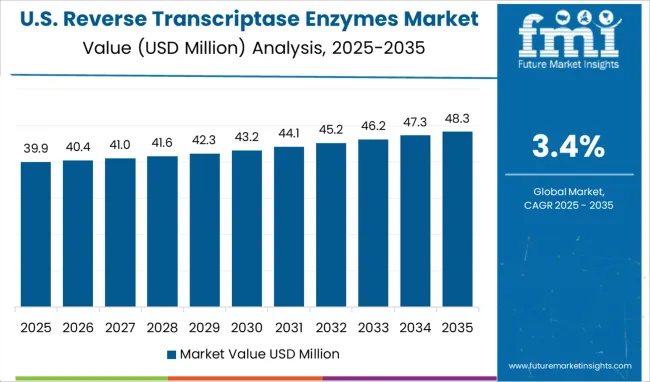
Geographically, the reverse transcriptase enzymes market is segmented into North America, Latin America, Western Europe, Eastern Europe, Asia Pacific, Japan, the Middle East, and Africa. As per the reverse transcriptase enzymes market survey, North America is anticipated to dominate the reverse transcriptase enzymes market share by acquiring 30.2% of the share during the forecast period.
Due to increasing healthcare expenditure as compared to other regions, the advanced research activities conducted by the various academic and pharmaceutical industries are likely to increase the reverse transcriptase enzymes market trends as well as the reverse transcriptase enzymes market opportunities.
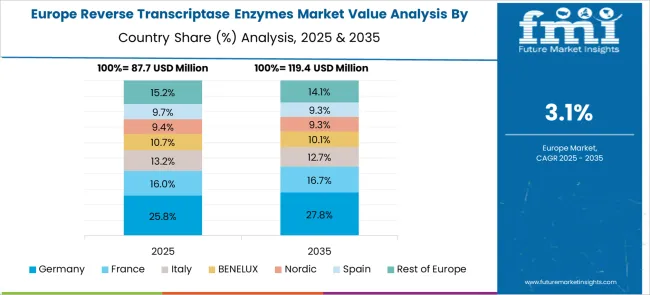
The Europe region stood the position second, after North America, in the reverse transcriptase enzymes market share, acquiring 27.5% of the share all around the regions as per the reverse transcriptase enzymes market report during the forecast period.
The Europe region is leading the reverse transcriptase enzymes market size by increasing awareness about the product and increasing research activities. This leads to growing the reverse transcriptase enzymes market key trends and opportunities in the region.
Several start-ups in the reverse transcriptase enzymes market are using the new innovative technology and scientific research to upsurge the reverse transcriptase enzyme adoption trends all around the region. They aim to dive into research on the various prospects related to science and come out with bringing new solutions.
The various start-ups are proving themselves to come up with new ideas and equipment for emerging trends in the reverse transcriptase enzymes market. One of the start-ups named Takara uses different applications, including real-time PCR, Complementary DNA library, and first-strand synthesis, among others, in the reverse transcriptase enzymes market.
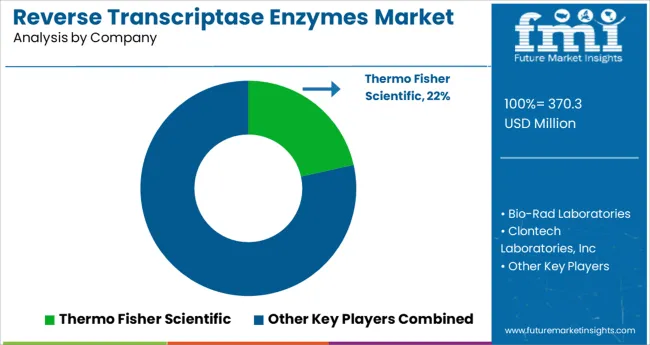
Some of the players in the reverse transcriptase enzymes market include Thermo Fisher Scientific, Bio-Rad Laboratories, Inc., Clontech Laboratories, Inc. (sub. Takara Bio Company), Biomatik., New England Biolabs, QIAGEN, Promega Corporation, AMS Biotechnology (Europe) Limited, and Cell Sciences.
These are the leading key industries that play a vital role in upsurging the reverse transcriptase enzymes market opportunities, as per the reverse transcriptase enzymes market report. These key competitors are using various tactics, including partnerships, mergers, acquisitions, and product launches, among others, to emerging trends in the reverse transcriptase enzymes market.
Recent Developments in the reverse Transcriptase Enzymes Market are:
| Report Attribute | Details |
|---|---|
| Growth Rate | CAGR of 3.4% from 2025 to 2035 |
| Base Year for Estimation | 2024 |
| Historical Data | 2020 to 2024 |
| Forecast Period | 2025 to 2035 |
| Quantitative Units | Revenue in million and CAGR from 2025 to 2035 |
| Report Coverage | Revenue Forecast, Volume Forecast, Company Ranking, Competitive Landscape, Growth Factors, Trends, and Pricing Analysis |
| Segments Covered | Product Type, Application, Region |
| Regions Covered | North America; Latin America; Europe; East Asia; South Asia; Oceania; Middle East and Africa |
| Key Countries Profiled | United States of America, Canada, Brazil, Argentina, Germany, United Kingdom, France, Spain, Italy, Nordics, BENELUX, Australia & New Zealand, China, India, ASIAN, GCC Countries, South Africa |
| Key Companies Profiled | Thermo Fisher Scientific; Bio-Rad Laboratories, Inc.; Clontech Laboratories, Inc. (sub. Takara Bio Company); Biomatik; New England Biolabs; QIAGEN; Promega Corporation; AMS Biotechnology (Europe) Limited and Cell Sciences |
| Customization | Available Upon Request |
The global reverse transcriptase enzymes market is estimated to be valued at USD 370.3 million in 2025.
It is projected to reach USD 517.4 million by 2035.
The market is expected to grow at a 3.4% CAGR between 2025 and 2035.
The key product types are research application and medical application.
reagents application segment is expected to dominate with a 48.0% industry share in 2025.






Our Research Products

The "Full Research Suite" delivers actionable market intel, deep dives on markets or technologies, so clients act faster, cut risk, and unlock growth.

The Leaderboard benchmarks and ranks top vendors, classifying them as Established Leaders, Leading Challengers, or Disruptors & Challengers.

Locates where complements amplify value and substitutes erode it, forecasting net impact by horizon

We deliver granular, decision-grade intel: market sizing, 5-year forecasts, pricing, adoption, usage, revenue, and operational KPIs—plus competitor tracking, regulation, and value chains—across 60 countries broadly.

Spot the shifts before they hit your P&L. We track inflection points, adoption curves, pricing moves, and ecosystem plays to show where demand is heading, why it is changing, and what to do next across high-growth markets and disruptive tech

Real-time reads of user behavior. We track shifting priorities, perceptions of today’s and next-gen services, and provider experience, then pace how fast tech moves from trial to adoption, blending buyer, consumer, and channel inputs with social signals (#WhySwitch, #UX).

Partner with our analyst team to build a custom report designed around your business priorities. From analysing market trends to assessing competitors or crafting bespoke datasets, we tailor insights to your needs.
Supplier Intelligence
Discovery & Profiling
Capacity & Footprint
Performance & Risk
Compliance & Governance
Commercial Readiness
Who Supplies Whom
Scorecards & Shortlists
Playbooks & Docs
Category Intelligence
Definition & Scope
Demand & Use Cases
Cost Drivers
Market Structure
Supply Chain Map
Trade & Policy
Operating Norms
Deliverables
Buyer Intelligence
Account Basics
Spend & Scope
Procurement Model
Vendor Requirements
Terms & Policies
Entry Strategy
Pain Points & Triggers
Outputs
Pricing Analysis
Benchmarks
Trends
Should-Cost
Indexation
Landed Cost
Commercial Terms
Deliverables
Brand Analysis
Positioning & Value Prop
Share & Presence
Customer Evidence
Go-to-Market
Digital & Reputation
Compliance & Trust
KPIs & Gaps
Outputs
Full Research Suite comprises of:
Market outlook & trends analysis
Interviews & case studies
Strategic recommendations
Vendor profiles & capabilities analysis
5-year forecasts
8 regions and 60+ country-level data splits
Market segment data splits
12 months of continuous data updates
DELIVERED AS:
PDF EXCEL ONLINE
Reverse Tuck Box Market Size and Share Forecast Outlook 2025 to 2035
Reverse Osmosis Pump Market Size and Share Forecast Outlook 2025 to 2035
Enzymes for Laundry Detergent Market Size and Share Forecast Outlook 2025 to 2035
Enzymes Market Size and Share Forecast Outlook 2025 to 2035
Enzymes for Water Treatment Market Size and Share Forecast Outlook 2025 to 2035
Reverse Cap Bottles Market Size and Share Forecast Outlook 2025 to 2035
Reverse Logistics Market Size and Share Forecast Outlook 2025 to 2035
Market Share Insights for Reverse Osmosis (RO) Pump Providers
Reverse Tuck Cartons Market
3D Reverse Engineering Software Market Forecast and Outlook 2025 to 2035
Meat Enzyme Market Analysis - Size and Share Forecast Outlook 2025 to 2035
Wine Enzymes Market Analysis Size Share and Forecast Outlook 2025 to 2035
Feed Enzymes Market Analysis - Size, Share, and Forecast Outlook 2025 to 2035
Dairy Enzymes Market Trends - Innovations & Demand 2025 to 2035
Bakery Enzymes Market Analysis - Size, Share, and Forecast Outlook 2025 to 2035
Marine Enzymes Market Analysis by Product Type, End User and Region through 2035
Brewing Enzymes Market Growth - Fermentation Efficiency & Industry Expansion 2024 to 2034
Biofuel Enzymes Market
Aquafeed Enzyme Market Analysis - Size, Share, & Forecast Outlook 2025 to 2035
Fish Roe Enzymes and Extracts Market Analysis by Type, Source and Application Through 2035

Thank you!
You will receive an email from our Business Development Manager. Please be sure to check your SPAM/JUNK folder too.
Chat With
MaRIA